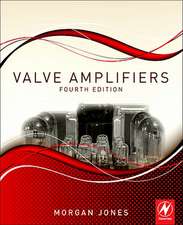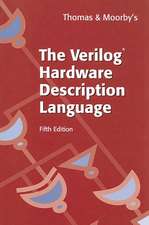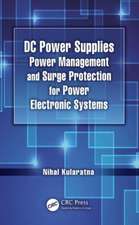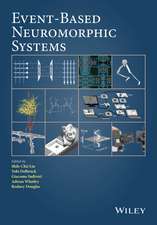Electromagnetic Behaviour of Metallic Wire Structures
Autor S. T. Chui, Lei Zhouen Limba Engleză Hardback – 17 iul 2012
Including both background material and detailed derivations of the various different formulae applied, Electromagnetic Behaviour of Metallic Wire Structures describes how to extend basic circuit theory relating to voltages, currents, and resistances of metallic wire networks to include situations where the currents are no longer spatially uniform along the wire. This lays a foundation for a deeper understanding of the many new phenomena observed in meta-electromagnetic materials.
Examples of applications are included to support this new approach making Electromagnetic Behaviour of Metallic Wire Structures a comprehensive and self-contained volume suitable for use by specialists, non-specialist, researchers and professionals in other relevant fields and even students.
| Toate formatele și edițiile | Preț | Express |
|---|---|---|
| Paperback (1) | 633.35 lei 6-8 săpt. | |
| SPRINGER LONDON – 9 aug 2014 | 633.35 lei 6-8 săpt. | |
| Hardback (1) | 637.59 lei 6-8 săpt. | |
| SPRINGER LONDON – 17 iul 2012 | 637.59 lei 6-8 săpt. |
Preț: 637.59 lei
Preț vechi: 750.11 lei
-15% Nou
Puncte Express: 956
Preț estimativ în valută:
122.02€ • 127.06$ • 103.12£
122.02€ • 127.06$ • 103.12£
Carte tipărită la comandă
Livrare economică 08-22 martie
Preluare comenzi: 021 569.72.76
Specificații
ISBN-13: 9781447141587
ISBN-10: 144714158X
Pagini: 161
Ilustrații: X, 142 p.
Dimensiuni: 155 x 235 x 20 mm
Greutate: 0.34 kg
Ediția:2013
Editura: SPRINGER LONDON
Colecția Springer
Locul publicării:London, United Kingdom
ISBN-10: 144714158X
Pagini: 161
Ilustrații: X, 142 p.
Dimensiuni: 155 x 235 x 20 mm
Greutate: 0.34 kg
Ediția:2013
Editura: SPRINGER LONDON
Colecția Springer
Locul publicării:London, United Kingdom
Public țintă
ResearchCuprins
Preface.- Introduction.- 1. Resonance properties of metallic ring systems: a single ring.- 2. Resonance properties of metallic ring systems: more complex structures.- 3. Helical structures.- 4. General multiply connected metallic wire networks: T and H.- 5. Jerusalem cross.- 6. Metallic wire structures under a moderate electromagnetic field.- 7. Electromagnetic waves in wire composites I: Plasmonics.- 8. Electromagnetic waves in wire composites II: anisotropic, off-diagonal magnetoelectric wire composites.
Notă biografică
Siu-Tat Chui was born in Hong Kong, China on April 20, 1949. He went to McGill University in 1967 and obtained his B.S. degree with first class honors in physics in 1969. After that he went to Princeton University and obtained a Ph.D. in physics in 1972. He remained an instructor at Princeton from 1972-73. He was a member of the Technical Staff at Bell Laboratories from 1973 to 1975, an Assistant Professor at SUNY-Albany from 1975 to 1979 and joined the Bartol Research Foundation, University of Delaware in 1979 and is currently professor. He is married and have two sons, one of whom is an artist. He hopes the income from this book can partly support his artist son.
Lei Zhou was born in Shandong, China on July 12, 1972. He went to Fudan University in 1988, and received his B.S. degree in physics in 1992 and his Ph.D. degree in physics in 1997. After that, he went to Institute for Material Research, Tohoku University, Japan, for postdoctoral research. In 2000, he left Japan for Hong Kong and became a visiting scholar in Physics Department, Hong Kong University of Science and Technology. In 2004, he joined Physics Department, Fudan University, China, and is currently a professor.
Lei Zhou was born in Shandong, China on July 12, 1972. He went to Fudan University in 1988, and received his B.S. degree in physics in 1992 and his Ph.D. degree in physics in 1997. After that, he went to Institute for Material Research, Tohoku University, Japan, for postdoctoral research. In 2000, he left Japan for Hong Kong and became a visiting scholar in Physics Department, Hong Kong University of Science and Technology. In 2004, he joined Physics Department, Fudan University, China, and is currently a professor.
Textul de pe ultima copertă
Despite the recent development and interest in the photonics of metallic wire structures, the relatively simple concepts and physics often remain obscured or poorly explained to those who do not specialize in the field. Electromagnetic Behaviour of Metallic Wire Structures provides a clear and coherent guide to understanding these phenomena without excessive numerical calculations.
Including both background material and detailed derivations of the various different formulae applied, Electromagnetic Behaviour of Metallic Wire Structures describes how to extend basic circuit theory relating to voltages, currents, and resistances of metallic wire networks to include situations where the currents are no longer spatially uniform along the wire. This lays a foundation for a deeper understanding of the many new phenomena observed in meta-electromagnetic materials.
Examples of applications are included to support this new approach making Electromagnetic Behaviour of Metallic Wire Structures a comprehensive and self-contained volume suitable for use by specialists, non-specialist, researchers and professionals in other relevant fields and even students.
Including both background material and detailed derivations of the various different formulae applied, Electromagnetic Behaviour of Metallic Wire Structures describes how to extend basic circuit theory relating to voltages, currents, and resistances of metallic wire networks to include situations where the currents are no longer spatially uniform along the wire. This lays a foundation for a deeper understanding of the many new phenomena observed in meta-electromagnetic materials.
Examples of applications are included to support this new approach making Electromagnetic Behaviour of Metallic Wire Structures a comprehensive and self-contained volume suitable for use by specialists, non-specialist, researchers and professionals in other relevant fields and even students.
Caracteristici
Describes how to extend basic circuit theory when currents are no longer spatially uniform along the wires Enables readers to understand many new phenomena relating to meta-electromagnetic materials made with metallic wire structures Provides examples of applications Includes supplementary material: sn.pub/extras












